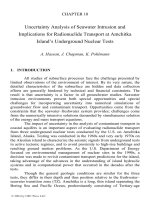Management 13th edtion by schermerhorn bachrach chapter 10
Bạn đang xem bản rút gọn của tài liệu. Xem và tải ngay bản đầy đủ của tài liệu tại đây (761.64 KB, 52 trang )
John R. Schermerhorn, Jr.
10
Daniel G. Bachrach
Management
th
13 edition
Chapter 10
Strategy and Strategic Management
Planning Ahead — Key Takeaways
Discuss the process and importance of strategic management.
Identify the essential elements in strategic analysis.
Explain alternative corporate strategies.
Explain alternative business-level strategies.
Describe the foundations for strategy implementation.
Copyright ©2015 John Wiley & Sons, Inc.
Chapter 10 Outline
1.
2.
Strategic Management
Competitive advantage
Strategy and strategic intent
Levels of strategy
Strategic management process
Essentials of Strategic Analysis
Analysis of mission, values, objectives
SWOT analysis of organization and environment
Five forces analysis of industry attractiveness
Strategic management process
Copyright ©2015 John Wiley & Sons, Inc.
Chapter 10 Outline
3.
4.
Corporate-Level Strategy Formulation
Portfolio planning model
Growth and diversification strategies
Retrenchment and restructuring strategies
Global strategies
Cooperative strategies
Business-Level Strategy Formulation
Competitive strategies model
Differentiation strategy
Cost leadership strategy
Focus strategy
Copyright ©2015 John Wiley & Sons, Inc.
Chapter 10 Outline
5.
Strategy Implementation
Management practices and systems
Strategic control and corporate governance
Strategic leadership
Copyright ©2015 John Wiley & Sons, Inc.
Strategic Management
Basic concepts of strategy:
Competitive advantage — ability to do something so well that one outperforms
competitors
Sustainable competitive advantage — one that is difficult or costly for
competitors to imitate
Copyright ©2015 John Wiley & Sons, Inc.
Strategic Management
Sources of competitive advantage
Technology
Cost and quality
Knowledge and speed
Barriers to entry
Financial resources
Copyright ©2015 John Wiley & Sons, Inc.
Strategic Management
Basic concepts of strategy:
Strategy
a comprehensive plan guiding resource allocation to achieve long-term organization
goals
Strategic intent
focusing all organizational energies on a unifying and compelling goal
Copyright ©2015 John Wiley & Sons, Inc.
Strategic Management
Levels of strategies
Corporate
Sets long-term direction for the total enterprise
Business
How a division or strategic business unit will compete in its product or service domain
Functional
Guides activities within one specific area of operations
Copyright ©2015 John Wiley & Sons, Inc.
Figure 10.1 Three levels of strategy in organizations- corporate,
business, functional strategies
Copyright ©2015 John Wiley & Sons, Inc.
Strategic Management
Strategic Management Process:
Strategic management
the process of formulating and implementing strategies to accomplish long-term goals
and sustain competitive advantage
Strategic analysis
process of analyzing the organization, the environment, its competitive position and
current strategies
Copyright ©2015 John Wiley & Sons, Inc.
Figure 10.2 Strategy formulation and implementation in the strategic
management process
Copyright ©2015 John Wiley & Sons, Inc.
Strategic Management
Strategy formulation
The process of creating strategy
Involves assessing existing strategies, organization, and environment to
develop new strategies and strategic plans capable of delivering future
competitive advantage
Copyright ©2015 John Wiley & Sons, Inc.
Strategic Management
Strategy implementation
The process of allocating resources and putting strategies into action
All organizational and management systems must be mobilized to support and
reinforce the accomplishment of strategies
Copyright ©2015 John Wiley & Sons, Inc.
Essentials of Strategic Analysis
Strategic Questions
• What is our business mission?
• Who are our customers?
• What do our customers value?
• What have been our results?
• What is our plan?
Copyright ©2015 John Wiley & Sons, Inc.
Essentials of Strategic Analysis
Analysis of mission:
The reason for an organization’s existence
Good mission statements identify:
What are we moving to?
What is our dream?
What kind of difference do we make?
What do we want to be known for?
An important test of the mission is how well it serves the organization’s
stakeholders
Copyright ©2015 John Wiley & Sons, Inc.
Essentials of Strategic Analysis
Stakeholders
Individuals and groups directly affected by the organization and its strategic
accomplishments
An important test of the mission is how well it serves the organization’s
stakeholders
Copyright ©2015 John Wiley & Sons, Inc.
Figure 10.3 How external stakeholders can be valued as strategic constituencies in an
organization’s mission statement
Copyright ©2015 John Wiley & Sons, Inc.
Essentials of Strategic Analysis
Analysis of Core values:
Broad beliefs about what is or is not appropriate behavior
Organizational culture reflects the predominant value system of the
organization as a whole
Copyright ©2015 John Wiley & Sons, Inc.
Essentials of Strategic Analysis
Analysis of objectives:
Operating objectives are specific results that organizations try to accomplish
Copyright ©2015 John Wiley & Sons, Inc.
Essentials of Strategic Analysis
Typical operating objectives of a business
include:
•
•
•
•
•
•
•
•
•
Profitability
Sustainability
Social responsibility
Financial health
Cost efficiency
Product quality
Market share
Human talent
Innovation
Copyright ©2015 John Wiley & Sons, Inc.
Essentials of Strategic Analysis
Analysis of organizational resources and capabilities:
Core competency is a special strength that gives an organization competitive
advantage
Important goal of assessing core competencies
Copyright ©2015 John Wiley & Sons, Inc.
Essentials of Strategic Analysis
Potential core competencies:
•
•
•
•
Special knowledge or expertise
Superior technology
Efficient supply chains
Unique product distribution systems
Copyright ©2015 John Wiley & Sons, Inc.
Essentials of Strategic Analysis
SWOT Analysis
Examination of an organization’s current position by looking at
Internal strengths and weaknesses
Environmental opportunities and threats
Copyright ©2015 John Wiley & Sons, Inc.
Figure 10.4 SWOT analysis of strengths, weaknesses, opportunities,
and threats
Copyright ©2015 John Wiley & Sons, Inc.









